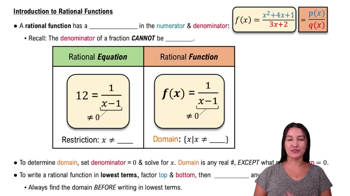Table of contents
- 0. Functions7h 52m
- Introduction to Functions16m
- Piecewise Functions10m
- Properties of Functions9m
- Common Functions1h 8m
- Transformations5m
- Combining Functions27m
- Exponent rules32m
- Exponential Functions28m
- Logarithmic Functions24m
- Properties of Logarithms34m
- Exponential & Logarithmic Equations35m
- Introduction to Trigonometric Functions38m
- Graphs of Trigonometric Functions44m
- Trigonometric Identities47m
- Inverse Trigonometric Functions48m
- 1. Limits and Continuity2h 2m
- 2. Intro to Derivatives1h 33m
- 3. Techniques of Differentiation3h 18m
- 4. Applications of Derivatives2h 38m
- 5. Graphical Applications of Derivatives6h 2m
- 6. Derivatives of Inverse, Exponential, & Logarithmic Functions2h 37m
- 7. Antiderivatives & Indefinite Integrals1h 26m
- 8. Definite Integrals4h 44m
- 9. Graphical Applications of Integrals2h 27m
- 10. Physics Applications of Integrals 2h 22m
1. Limits and Continuity
Finding Limits Algebraically
Problem 2.48d
Textbook Question
Horizontal and Vertical Asymptotes
Use limits to determine the equations for all horizontal asymptotes.
_________
/ x² + 9
d. y = / -------------
√ 9x² + 1
 Verified step by step guidance
Verified step by step guidance1
Identify the function for which we need to find the horizontal asymptotes: \( y = \frac{\sqrt{x^2 + 9}}{\sqrt{9x^2 + 1}} \).
To find horizontal asymptotes, evaluate the limit of the function as \( x \to \infty \) and \( x \to -\infty \).
Simplify the expression under the square roots by factoring out the highest power of \( x \) from both the numerator and the denominator. This involves rewriting \( \sqrt{x^2 + 9} \) as \( \sqrt{x^2(1 + \frac{9}{x^2})} = |x|\sqrt{1 + \frac{9}{x^2}} \) and \( \sqrt{9x^2 + 1} \) as \( \sqrt{x^2(9 + \frac{1}{x^2})} = |x|\sqrt{9 + \frac{1}{x^2}} \).
Substitute these simplified forms back into the original function: \( y = \frac{|x|\sqrt{1 + \frac{9}{x^2}}}{|x|\sqrt{9 + \frac{1}{x^2}}} \). Cancel out \( |x| \) from the numerator and the denominator.
Evaluate the limit of the simplified expression as \( x \to \infty \) and \( x \to -\infty \). The expression simplifies to \( \frac{\sqrt{1 + \frac{9}{x^2}}}{\sqrt{9 + \frac{1}{x^2}}} \), which approaches \( \frac{1}{3} \) as \( x \to \infty \) and \( x \to -\infty \). Thus, the horizontal asymptote is \( y = \frac{1}{3} \).
 Verified video answer for a similar problem:
Verified video answer for a similar problem:This video solution was recommended by our tutors as helpful for the problem above
Video duration:
4mPlay a video:
Was this helpful?
Key Concepts
Here are the essential concepts you must grasp in order to answer the question correctly.
Limits
Limits are fundamental in calculus, representing the value that a function approaches as the input approaches a certain point. They are essential for analyzing the behavior of functions at specific points, particularly at infinity, which is crucial for determining asymptotes. Understanding limits allows us to evaluate the end behavior of rational functions and identify horizontal asymptotes.
Recommended video:

One-Sided Limits
Horizontal Asymptotes
Horizontal asymptotes describe the behavior of a function as the input approaches infinity or negative infinity. They indicate the value that the function approaches in the horizontal direction, which can be determined using limits. For rational functions, horizontal asymptotes can often be found by comparing the degrees of the numerator and denominator.
Recommended video:

Graphs of Exponential Functions
Rational Functions
Rational functions are expressions formed by the ratio of two polynomials. They are significant in calculus for analyzing their limits and asymptotic behavior. The degrees of the polynomials in the numerator and denominator play a critical role in determining the existence and location of horizontal asymptotes, making it essential to understand their structure.
Recommended video:

Intro to Rational Functions

 5:21m
5:21mWatch next
Master Finding Limits by Direct Substitution with a bite sized video explanation from Callie
Start learningRelated Videos
Related Practice







